
Dermestidae are a family of Coleoptera that are commonly referred to as skin beetles. Other common names include larder beetle, hide or leather beetles, carpet beetles, and khapra beetles. There are over 1,100 species described.

The flea beetle is a small, jumping beetle of the leaf beetle family (Chrysomelidae), that makes up the tribe Alticini which is part of the subfamily Galerucinae. Historically the flea beetles were classified as their own subfamily.
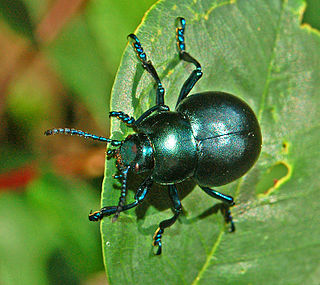
Timarcha is a genus of leaf beetles in the family Chrysomelidae, with more than 100 described species in three subgenera. The most widely known species is T. tenebricosa, the bloody-nosed beetle. All species are black, wingless organisms. Timarcha are herbivorous species, living mostly on plants belonging to Rubiaceae and Plumbaginaceae, although a few can feed on Brassicaceae and Rosaceae. Timarcha is the only member of the tribe Timarchini.
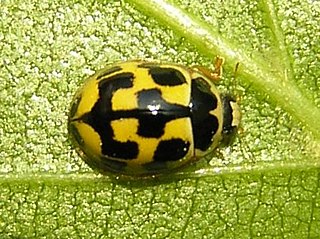
Propylea quatuordecimpunctata is a small lady beetle, belonging to the family Coccinellidae. It is sometimes referred to by the common name 14-spotted ladybird beetle, or simply P-14.
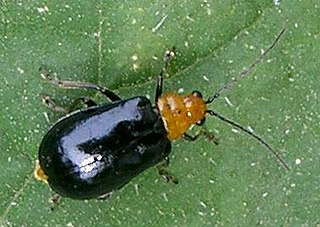
Aulacophora is a genus of beetles in the family Chrysomelidae, commonly known as pumpkin beetles; some species are pests of agricultural crops. The genus was named in 1836 by the French entomologist Louis Alexandre Auguste Chevrolat, in Dejean's Catalogue des Coléoptères. The name, from Ancient Greek, signifies "furrow-bearer"' from aulax, "furrow".

Longitarsus quadriguttatus is a species of beetle in the leaf beetle family. It is distributed in Central and south-eastern Europe, Asia Minor and the Caucasus. Adults and larvae feed on the leaves of Boraginaceae species, as well as Cynoglossum officinale and Echium vulgare.

Lachnaia is a genus of leaf beetles in the subfamily Cryptocephalinae, tribe Clytrini. Multiple species in this genus are known to be myrmecophiles, such as the larvae of L. italica.

Lachnaia variolosa is a species of leaf beetles from the subfamily Cryptocephalinae that can be found in Algeria, Morocco and southern Spain.

Colasposoma is a genus of leaf beetles in the subfamily Eumolpinae. It is known from Africa, Asia and Australia.

Cryptocephalus trimaculatus is a species of cylindrical leaf beetle belonging to the family Chrysomelidae, subfamily Cryptocephalinae.

Novius is a genus of ladybird beetles belonging to the family Coccinellidae, and the sole member of the tribe Noviini. The genus as presently defined contains over 70 species, most of which were formerly placed in the genera Rodolia and Anovia, but after decades of debate, both of these genera are now considered to be junior synonyms of Novius.

Aphidecta obliterata is a species of Coccinellidae, a flying beetle.

Galerucini is a tribe of skeletonizing leaf beetles in the family Chrysomelidae. There are more than 70 genera and at least 480 described species in Galerucini.

Brachypnoea is a genus of leaf beetles in the subfamily Eumolpinae. It is mostly found in the Neotropical realm, though there are also eight known species in the Nearctic realm.
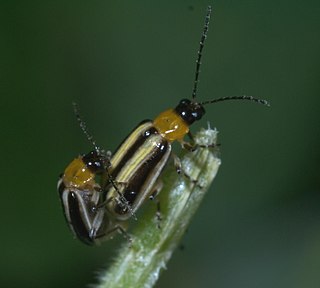
Luperini is a tribe of skeletonizing leaf beetles in the family Chrysomelidae. There are more than 30 genera and 500 described species in Luperini.
Xenochalepus is a genus of tortoise beetles and hispines in the family Chrysomelidae. There are more than 90 described species in Xenochalepus.
Euryope is a genus of leaf beetles in the subfamily Eumolpinae. It is distributed in Africa and the Arabian Peninsula.
Aphilenia is a genus of leaf beetles in the subfamily Eumolpinae. It is distributed in Central and East Asia as well as southern Russia. Members of the genus are adapted to dry climates, and feed on bushes of the genus Calligonum. In 2012, the genus was moved from the tribe Bromiini to the tribe Nodinini.
Thysbina is a genus of leaf beetles in the subfamily Eumolpinae. It is known from Africa. It was first established by the German entomologist Julius Weise in 1902, for several species from Colasposoma as well as three new species. According to Louis Jules Léon Burgeon in 1941, Thysbina is actually a synonym of Colasposoma, though this proposed synonymy has been ignored in later works.
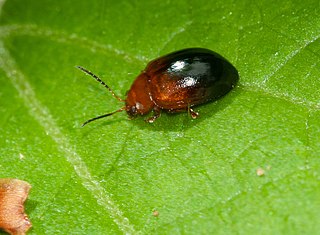
Nisotra is a genus of flea beetles in the family Chrysomelidae. They are found in Africa, Asia, and Australia. There are around 90 described species in Nisotra, including about 70 in Sub-Saharan Africa and Madagascar. Many of these species are agricultural pests.

















